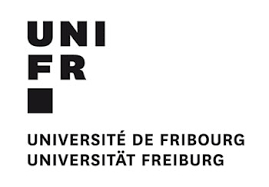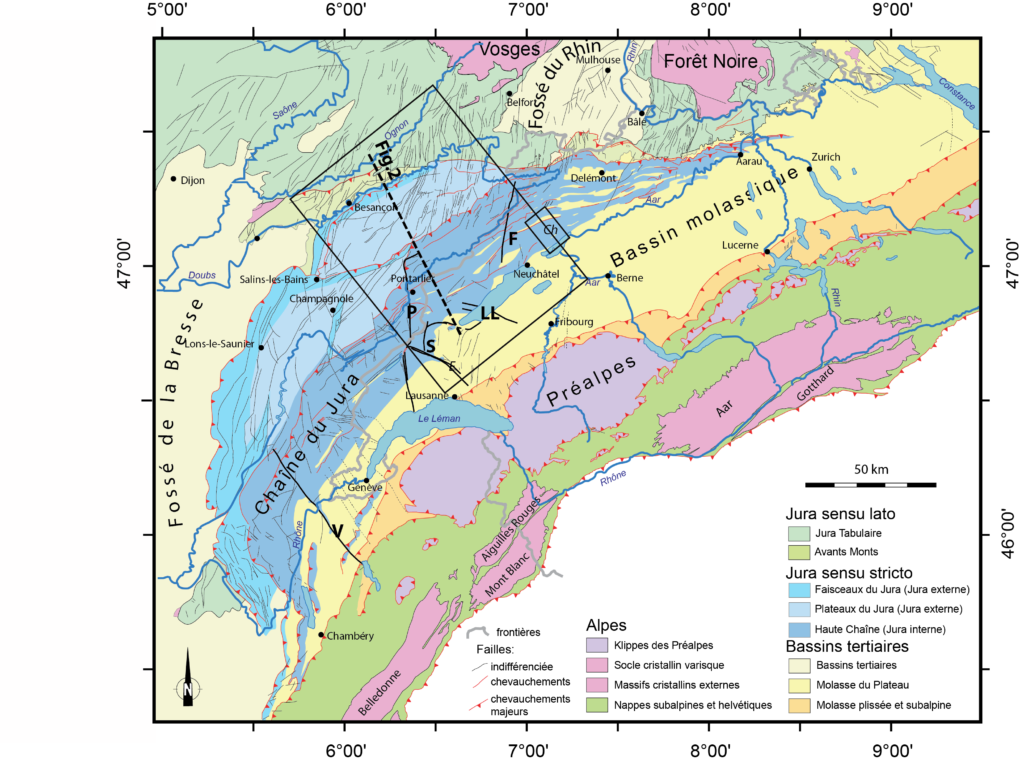
The Jura Mountains are located to the N and NW of the Western Alpine Molasse Basin. The Jura foreland fold-and-thrust belt is generally considered to be a classic detachment belt developed over a major décollement level in Triassic evaporites above the “undeformed” basement s.l. and formed by fault- and ramp-related folding in its central and western part and by detachment folding in its eastern part. Deformation processes, including dissolution-precipitation (such as, pressure shadows, veins and stylolithes), fracturing, cataclastic flow, are in the brittle field (except for the plastically deformed Triassic evaporites in the décollement zone) and since the first proposal of the “Fernschub” theory by Buxtorf in 1907 most interpretations (including balanced cross-sections) consider that the major thrust faults root in a single décollement level above the basement s.l. and propagate towards the foreland (thin-skinned tectonics). Thus the “mechanical” basement s.l. – which is formed by Paleozoic series including Permo-Carboniferous grabens and the lower Triassic siliciclastic series – is not involved in the décollement-related folding and thrusting. This also implies that the strike-slip fault systems typical throughout the Jura Mountains are decoupled from the basement s.l.. However, the possibility of inversion of basement grabens has been considered, in particular to explain topographically elevated structures (baselines of synclines; thick-skinned tectonics). Recent studies also highlight the relevance of basement topography such as found at the Permo-Carboniferous graben edges, in localizing deformation and leading to the initiation of fault related folds and ramp systems. Numerous synclines containing Tertiary Molasse-type sediments indicate that the Jura fold-and-thrust belt formed after deposition of these sediments starting in Middle Miocene. Recent work has shown that deformation in the Jura Mountains lasted into the Pleistocene and is probably still active as suggested by ongoing seismicity.
In our project we challenge several aspects of the “classic” view. To this end we will use new forward kinematic modelling capabilities of several software packages such as Move (Midland Valley) in addition to geometric balancing techniques. We investigate how strain is partitioned between fold-and-thrust structures, basement inversion/faulting, and strike-slip faulting, as well as, within fold-and-thrust systems. Our analyses will include paleo-stress information collected in the field in combination with 2D and 3D stress modelling on faults with special attention to thrusts and strike-slip faults (Tectonics FP, Faultkinematics; Stress 3D, Move).
Read More
Our area of focus will be the Central Jura Mountains between Lake Neuchâtel to the SE and the front of the fold-and-thrust belt to the NW in the vicinity of the Ognon river and the city of Besançon. We focus on several major transects intergrated in a regional study.

We have the following objectives: [i] develop for the first time a kinematically viable model across the entire Central Jura Mountains; [ii] demonstrate the importance and ubiquity of multiple detachment horizons (in particular in the Triassic Muschelkalk evaporites and the Jurassic Opalinuston shales) in the evolution of the fold-and-thrust belt; [iii] determine a new spatio-temporal evolution of the thrust and fold development of the Jura Mountains; [iv] assess the involvement of the basement at the different stages of the formation of the fold-and-thrust belt based on kinematic modelling; [v] elaborate the strain partitioning between fault-related folds and strike-slip fault deformation; [vi] integrate paleo-stress data with a modelled 3D stress field with special attention on strike-slip fault systems and on reverse faulting [vii] quantify strain associated to dissolution-precipitation processes; and [viii] propose mechanical and process oriented insight from analogue modelling.
The novel and innovative aspect of our project resides in [i] the kinematic modelling and the use of multiple detachment horizons, [ii] the importance of the top basement s.l. topography, [iii] the integration of specifically designed analogue models, and [vi] the integration of field data on paleostress, deformation and 3D stress modelling both on thrusts and strike-slip faults in a regional context.